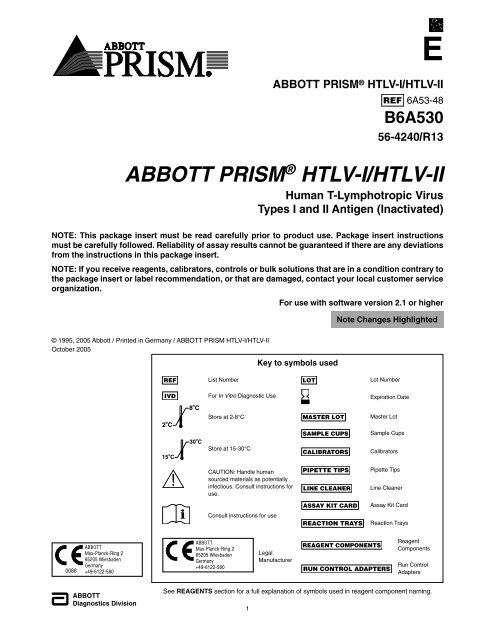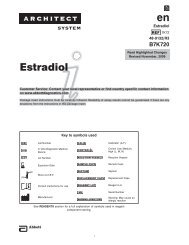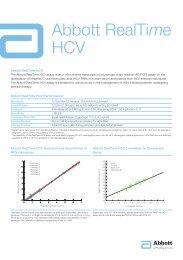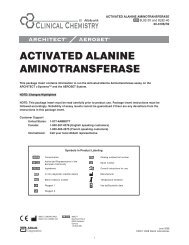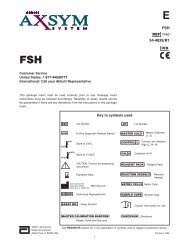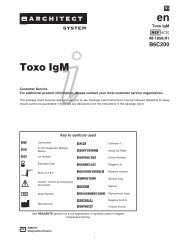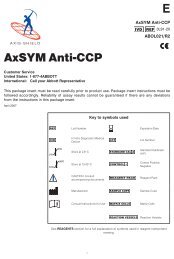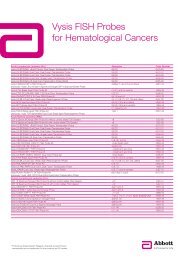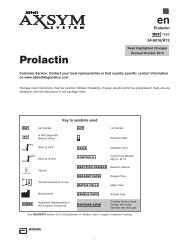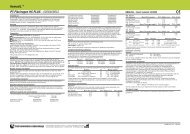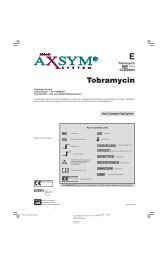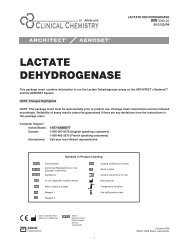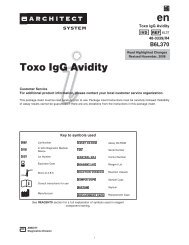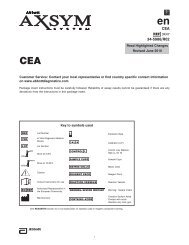ABBOTT PRISM® HTLV-I/HTLV-II - ILEX Medical Systems
ABBOTT PRISM® HTLV-I/HTLV-II - ILEX Medical Systems
ABBOTT PRISM® HTLV-I/HTLV-II - ILEX Medical Systems
You also want an ePaper? Increase the reach of your titles
YUMPU automatically turns print PDFs into web optimized ePapers that Google loves.
© 1995, 2005 Abbott / Printed in Germany / <strong>ABBOTT</strong> PRISM <strong>HTLV</strong>-I/<strong>HTLV</strong>-<strong>II</strong><br />
October 2005<br />
<strong>ABBOTT</strong><br />
Diagnostics Division<br />
Store at 2-8°C<br />
1<br />
E<br />
<strong>ABBOTT</strong> PRISM ® <strong>HTLV</strong>-I/<strong>HTLV</strong>-<strong>II</strong><br />
6A53-48<br />
B6A530<br />
56-4240/R13<br />
<strong>ABBOTT</strong> PRISM ® <strong>HTLV</strong>-I/<strong>HTLV</strong>-<strong>II</strong><br />
Human T-Lymphotropic Virus<br />
Types I and <strong>II</strong> Antigen (Inactivated)<br />
NOTE: This package insert must be read carefully prior to product use. Package insert instructions<br />
must be carefully followed. Reliability of assay results cannot be guaranteed if there are any deviations<br />
from the instructions in this package insert.<br />
NOTE: If you receive reagents, calibrators, controls or bulk solutions that are in a condition contrary to<br />
the package insert or label recommendation, or that are damaged, contact your local customer service<br />
organization.<br />
For use with software version 2.1 or higher<br />
0088<br />
List Number<br />
Key to symbols used<br />
For In Vitro Diagnostic Use Expiration Date<br />
Store at 15-30°C<br />
CAUTION: Handle human<br />
sourced materials as potentially<br />
infectious. Consult instructions for<br />
use.<br />
Consult instructions for use<br />
Legal<br />
Manufacturer<br />
Note Changes Highlighted<br />
Lot Number<br />
Master Lot<br />
Sample Cups<br />
Calibrators<br />
Pipette Tips<br />
Line Cleaner<br />
Assay Kit Card<br />
Reaction Trays<br />
Reagent<br />
Components<br />
Run Control<br />
Adapters<br />
See REAGENTS section for a full explanation of symbols used in reagent component naming.
U. S. Patent No. 4, 380, 580, licensed under patent rights of Bayer Corp. Tarrytown,<br />
New York, USA, relates to this product.<br />
NAME AND INTENDED USE<br />
The <strong>ABBOTT</strong> PRISM ® <strong>HTLV</strong>-I/<strong>HTLV</strong>-<strong>II</strong> assay is an in vitro chemiluminescent<br />
immunoassay (ChLIA) for the qualitative detection of antibodies to human<br />
T-lymphotropic virus type I and/or human T-lymphotropic virus type <strong>II</strong> (anti-<strong>HTLV</strong>-I/<br />
<strong>HTLV</strong>-<strong>II</strong>) in human serum or plasma. The <strong>ABBOTT</strong> PRISM <strong>HTLV</strong>-I/<strong>HTLV</strong>-<strong>II</strong> ChLIA<br />
is intended as a screen for donated blood to prevent transmission of <strong>HTLV</strong>-I and<br />
<strong>HTLV</strong>-<strong>II</strong> to recipients of blood and blood components and as an aid in the diagnosis<br />
of <strong>HTLV</strong>-I and <strong>HTLV</strong>-<strong>II</strong> infections.<br />
SUMMARY AND EXPLANATION OF THE TEST<br />
<strong>HTLV</strong>-I, a human Type-C retrovirus, 1,2 has been etiologically associated with<br />
neoplastic conditions and a variety of demyelinating neurologic disorders including:<br />
adult T-cell leukemia (ATL), 3 tropical spastic paraparesis (TSP) 4,5 and/or <strong>HTLV</strong>-I<br />
associated myelopathy (HAM) 6 and more recently <strong>HTLV</strong>-I associated polymyositis,<br />
arthritis and infective dermatitis. 7-9 Antibodies to <strong>HTLV</strong>-I are found with high<br />
frequency in persons afflicted with these disorders. However, it is well established<br />
in studies from viral endemic areas that <strong>HTLV</strong>-I antibody negative ATL and TSP/HAM<br />
are seen. 10-12<br />
<strong>HTLV</strong>-I infection is endemic in the Caribbean, 11 south-eastern Japan, 12 in some<br />
areas of Africa, 13 Central and South America, 14 and recently described in<br />
Melanesia 15,16 and central and northern Australia. 17,18 In the United States, <strong>HTLV</strong>-I<br />
has been identified in ATL patients, intravenous drug users and in healthy<br />
individuals. 19-23 Transmission of <strong>HTLV</strong>-I (and <strong>HTLV</strong>-<strong>II</strong>) infection to transfusion<br />
recipients of infected cellular blood products is well documented. 24-29 Transmission<br />
also occurs via breast milk, 30 sexual contact, 31,32 and sharing of contaminated<br />
needles and syringes by intravenous drug users. 20,23,33<br />
<strong>HTLV</strong>-I causes ATL in only 2 to 4% of infected individuals and typically only after<br />
long latency periods. 34,35 The ATL syndrome appears to result from exposure early<br />
in life as occurs during maternal transmission via breast milk. 30 Approximately 20<br />
to 25% of children exposed to <strong>HTLV</strong>-I through breast feeding develop antibodies to<br />
<strong>HTLV</strong>-I. 30,36-38 Perinatal transmission of <strong>HTLV</strong>-I occurs in approximately 5% of nonbreast<br />
fed children born to infected mothers. 37,38 Following transfusion of cellular<br />
blood components in <strong>HTLV</strong>-I endemic areas, 44 to 63% of recipients<br />
seroconvert; 25,39 however, lower seroconversion rates (approximately 20%) have<br />
been reported in recipients of contaminated blood in the U.S. 27,28 Infection with<br />
<strong>HTLV</strong>-I during adult life results in TSP/HAM-like illness, and not in ATL. 9 The lifetime<br />
risk for TSP/HAM for those who live in an endemic area is estimated at less than<br />
1%. 34,35 The presence of <strong>HTLV</strong>-I antibodies in an asymptomatic person indicates<br />
that the individual may be infected with the virus and should not donate blood, 38,40,41<br />
but does not mean the individual has ATL or TSP/HAM or will develop ATL or<br />
TSP/HAM. 34,38,41 Consultation with appropriate medical personnel is recommended<br />
for discussion of additional concerns related to viral infection and its transmission.<br />
<strong>HTLV</strong>-<strong>II</strong> was first isolated from a patient having T-lymphocytic-hairy cell<br />
leukemia. 42,43 Association of <strong>HTLV</strong>-<strong>II</strong> with leukemia pathogenesis is not well<br />
established; however, some cases of neurologic diseases resembling TSP/HAM<br />
have been recently reported to be due to <strong>HTLV</strong>-<strong>II</strong>. 44-47 Epidemiologic data suggest<br />
that <strong>HTLV</strong>-<strong>II</strong> is a new-world virus common among Amerindians in North, Central<br />
and South America. 14<br />
Transmission of <strong>HTLV</strong>-<strong>II</strong>, like <strong>HTLV</strong>-I, occurs via transfusion of cellular blood<br />
components, between needle-sharing intravenous drug users and through sexual<br />
contact, 14,23,48-51 but mother to child transmission of <strong>HTLV</strong>-<strong>II</strong> has recently been<br />
reported. 52 At least one-half of U.S. blood donors who confirm positive for antibody<br />
following <strong>HTLV</strong>-I screening have been identified as <strong>HTLV</strong>-<strong>II</strong> positive rather<br />
than <strong>HTLV</strong>-I positive. 23,28,38,44,53<br />
Neither <strong>HTLV</strong>-I nor <strong>HTLV</strong>-<strong>II</strong> cause acquired immunodeficiency syndrome (AIDS)<br />
and the <strong>HTLV</strong>-I and <strong>HTLV</strong>-<strong>II</strong> viruses are only remotely related to the AIDS virus,<br />
HIV. No cross-reactivity with antibodies to HIV-1 or HIV-2 has been demonstrated<br />
for this assay. The finding of antibodies to <strong>HTLV</strong>-I/<strong>HTLV</strong>-<strong>II</strong> by this assay has no<br />
relationship to the presence of antibodies to HIV and does not imply any risk of<br />
AIDS.<br />
The <strong>ABBOTT</strong> PRISM <strong>HTLV</strong>-I/<strong>HTLV</strong>-<strong>II</strong> assay has been developed to detect<br />
antibodies to <strong>HTLV</strong>-I and <strong>HTLV</strong>-<strong>II</strong> in human serum or plasma. This detection is<br />
accomplished through the presence of <strong>HTLV</strong>-I and <strong>HTLV</strong>-<strong>II</strong> viral antigens on the<br />
solid phase. The <strong>ABBOTT</strong> PRISM <strong>HTLV</strong>-I/<strong>HTLV</strong>-<strong>II</strong> assay does not discriminate<br />
between antibody reactivity to <strong>HTLV</strong>-I and <strong>HTLV</strong>-<strong>II</strong>.<br />
Specimens which are not reactive by the <strong>ABBOTT</strong> PRISM <strong>HTLV</strong>-I/<strong>HTLV</strong>-<strong>II</strong> assay<br />
are considered negative for antibodies to <strong>HTLV</strong>-I and <strong>HTLV</strong>-<strong>II</strong>. These specimens<br />
need not be tested further. Specimens which are initially reactive should be retested<br />
in duplicate. Reactivity in either or both of these duplicate tests (i.e., repeatedly<br />
reactive) is highly predictive of the presence of <strong>HTLV</strong>-I and/or <strong>HTLV</strong>-<strong>II</strong> antibodies in<br />
people at risk for <strong>HTLV</strong> infection. However, as for enzyme immunoassays, the<br />
<strong>ABBOTT</strong> PRISM <strong>HTLV</strong>-I/<strong>HTLV</strong>-<strong>II</strong> assay may yield non-specific reactions due to<br />
other causes, particularly when testing low prevalence populations (e.g., blood<br />
donors). A specimen which is found repeatedly reactive should be investigated<br />
further in supplemental tests, such as <strong>HTLV</strong> specific immunoassays, 9<br />
immunoblotting, immunoprecipitation assays, or a combination thereof.<br />
An <strong>HTLV</strong>-I, <strong>HTLV</strong>-<strong>II</strong>, or dual infection can only be differentiated serologically by<br />
parallel testing using antigens from <strong>HTLV</strong>-I and <strong>HTLV</strong>-<strong>II</strong> in specific<br />
immunoassays. 54,55 Tests based on reactivities to <strong>HTLV</strong>-I and <strong>HTLV</strong>-<strong>II</strong> type specific<br />
proteins may enable viral typing. Nonserologic tests based on the presence of<br />
infected cells, or <strong>HTLV</strong>-I/<strong>HTLV</strong>-<strong>II</strong> DNA probe testing [e.g., polymerase chain reaction<br />
(PCR)] may also be used in discrimination. 56<br />
2<br />
Recommendation for appropriate use of additional supplemental confirmatory and/<br />
or differential tests may be issued periodically by the U.S. Public Health Service. 38,41<br />
BIOLOGICAL PRINCIPLES OF THE PROCEDURE<br />
The <strong>ABBOTT</strong> PRISM <strong>HTLV</strong>-I/<strong>HTLV</strong>-<strong>II</strong> assay is a three-step sandwich ChLIA. The<br />
reactions occur in the following sequence:<br />
• Microparticles coated with sonicated and detergent-inactivated <strong>HTLV</strong>-I and<br />
<strong>HTLV</strong>-<strong>II</strong> antigens are incubated with either plasma, serum, calibrator, or control<br />
(sample) in the incubation well of the reaction tray. During incubation, <strong>HTLV</strong>-I<br />
and/or <strong>HTLV</strong>-<strong>II</strong> antibodies present in the sample bind to the antigen on the<br />
Microparticles.<br />
• After this first incubation is complete, the reaction mixture is transferred to the<br />
glass fiber matrix (matrix) of the reaction tray using the Transfer Wash. The<br />
Microparticles are captured by the matrix, while the remaining mixture flows<br />
through to the absorbent blotter.<br />
• A Probe consisting of biotinylated <strong>HTLV</strong>-I and <strong>HTLV</strong>-<strong>II</strong> proteins is added to the<br />
Microparticles on the matrix and incubated. The Probe binds to the <strong>HTLV</strong>-I/<br />
<strong>HTLV</strong>-<strong>II</strong> Microparticle-antibody complex created during the first incubation<br />
process. After the second incubation, the unbound Probe is washed into the<br />
blotter with Probe Wash.<br />
• The Acridinium-Labeled Anti-Biotin Conjugate is added to the Microparticles<br />
on the matrix to bind any Probe that is present. After the third incubation, the<br />
unbound Conjugate is washed into the blotter with the Conjugate Wash.<br />
• The chemiluminescent signal is generated by addition of an alkaline hydrogen<br />
peroxide solution and the resultant photons are counted.<br />
The amount of light emitted is proportional to the amount of anti-<strong>HTLV</strong>-I and/or<br />
anti-<strong>HTLV</strong>-<strong>II</strong> in the sample. For further information regarding ChLIA technology,<br />
refer to the <strong>ABBOTT</strong> PRISM Operations Manual, Section 3. The presence or<br />
absence of anti-<strong>HTLV</strong>-I/<strong>HTLV</strong>-<strong>II</strong> in the sample is determined by comparing the<br />
number of photons collected from the sample to a cutoff value determined from an<br />
<strong>ABBOTT</strong> PRISM calibration performed in the same batch. If the number of photons<br />
collected from a test sample is greater than or equal to the cutoff value, the sample<br />
is considered reactive for anti-<strong>HTLV</strong>-I and/or anti-<strong>HTLV</strong>-<strong>II</strong>. Specimens which are<br />
not reactive by the <strong>ABBOTT</strong> PRISM <strong>HTLV</strong>-I/<strong>HTLV</strong>-<strong>II</strong> assay are considered<br />
negative for anti-<strong>HTLV</strong>-I or anti-<strong>HTLV</strong>-<strong>II</strong>. These specimens need not be further<br />
tested. Specimens which are initially reactive should be centrifuged according to<br />
the table in the Specimen Collection and Preparation for Analysis section and<br />
retested in duplicate.<br />
REAGENTS<br />
NOTE: Each specific component description noted below is accompanied<br />
by a unique symbol. These symbols appear on both the component labels<br />
and on corresponding instrument tubing identifier labels. They are meant to<br />
facilitate identification and installation of reagent bottles within the ambient<br />
reagent bay and refrigerator.<br />
<strong>ABBOTT</strong> PRISM <strong>HTLV</strong>-I/<strong>HTLV</strong>-<strong>II</strong> Assay Kit (6A53-48)<br />
• 1 bottle (319 mL) <strong>HTLV</strong>-I/<strong>HTLV</strong>-<strong>II</strong> Antigen (Inactivated)<br />
Coated Microparticles in Phosphate Buffer with Tween ® * 20 and Protein<br />
Stabilizers. Preservative: Sodium Azide. (Symbol: ●)<br />
• 1 bottle (331 mL) Anti-Biotin (Mouse Monoclonal): Acridinium<br />
Conjugate in Phosphate Buffered Saline with Triton ®** X-100 and Protein<br />
Stabilizers. Minimum Concentration: 0.025 µg/mL. Preservative: Sodium Azide.<br />
(Symbol: ▲)<br />
• 3 bottles (10.4 mL each) Negative Calibrator (Human). Recalcified,<br />
Heat-Inactivated Plasma Nonreactive for HBsAg, HIV RNA or HIV-1 Ag,<br />
Anti-HCV, Anti-HIV-1/HIV-2, and Anti-<strong>HTLV</strong>-I/<strong>HTLV</strong>-<strong>II</strong>. Preservative: Sodium<br />
Azide. (Symbol: NC)<br />
• 3 bottles (10.4 mL each) <strong>HTLV</strong>-I Positive Calibrator (Human).<br />
Recalcified, Heat-Inactivated Plasma Reactive for Anti-<strong>HTLV</strong>-I, and Nonreactive<br />
for HBsAg, HIV RNA or HIV-1 Ag, Anti-HCV and Anti-HIV-1/HIV-2. <strong>HTLV</strong>-I<br />
Positive Calibrator may be cross-reactive for antibody to <strong>HTLV</strong>-<strong>II</strong>. Preservative:<br />
Sodium Azide. (Symbol: PC)<br />
• 3 bottles (10.4 mL each) <strong>HTLV</strong>-<strong>II</strong> Positive Assay Control (1)<br />
(Human). Recalcified, Heat-Inactivated Plasma Reactive for Anti-<strong>HTLV</strong>-<strong>II</strong>,<br />
Nonreactive for HBsAg, HIV RNA or HIV-1 Ag, Anti-HCV and Anti-HIV-1/HIV-2.<br />
<strong>HTLV</strong>-<strong>II</strong> Positive Assay Control (1) may be cross-reactive for antibody to <strong>HTLV</strong>-I.<br />
Preservative: Sodium Azide. (Symbol: PC2)<br />
• 1 bottle (324 mL) <strong>HTLV</strong>-I/<strong>HTLV</strong>-<strong>II</strong> Antigen (Inactivated) Biotinylated<br />
Probe. Biotinylated <strong>HTLV</strong>-I, <strong>HTLV</strong>-<strong>II</strong>, and <strong>HTLV</strong>-I Envelope Enriched Viral Lysate<br />
in TRIS Buffered Saline with Calf Serum and Protein Stabilizers.<br />
Preservative: ProClin ®*** 300. (Symbol: ■)<br />
<strong>ABBOTT</strong> PRISM <strong>HTLV</strong>-I/<strong>HTLV</strong>-<strong>II</strong> Wash Kit (6A53-38)<br />
• 1 bottle (3342 mL) Transfer Wash. Phosphate Buffered<br />
Saline. Preservative: Sodium Azide. (Symbol: ~)<br />
• 1 bottle (1725 mL) Conjugate Wash. MES<br />
{2-(N-morpholino)ethanesulfonic Acid} Buffered Saline. Preservative:<br />
ProClin 300. (Symbol: ★)<br />
* Tween is a registered trademark of ICI Americas.<br />
** Triton is a registered trademark of Union Carbide Co., Inc.<br />
*** ProClin is a registered trademark of Rohm & Haas.
• PROBE WASH 1 bottle (1718 mL) Probe Wash. TRIS Buffered Saline with<br />
Triton X-100. Preservatives: ProClin 300 and Sodium Azide. (Symbol: ➜)<br />
<strong>ABBOTT</strong> PRISM Activator Concentrate (1A75-02 or 3L27-02)<br />
• 4 bottles (900 mL each) Activator<br />
Concentrate. 0.4% Hydrogen Peroxide/0.06% Diethylenetriaminepentaacetic<br />
Acid.<br />
<strong>ABBOTT</strong> PRISM Activator Diluent (1A75-01 or 3L27-01)<br />
• 4 bottles (900 mL each) Activator Diluent. 0.3N<br />
Sodium Hydroxide.<br />
Other Reagents Available<br />
<strong>ABBOTT</strong> PRISM Run Control Kit (5E22-10)<br />
• 2 Bottles (10 mL each) Positive Control (Human). Purified<br />
anti-HBc IgG (Concentration: 0.9 - 2.6 PEI* Units/mL) and recalcified,<br />
heat-inactivated plasma reactive for HBsAg (HBsAg Concentration:<br />
0.10 - 0.40 ng/mL [0.01 - 0.05 PEI Units/mL]), anti-HCV, anti-HIV-1, and<br />
anti-<strong>HTLV</strong>-I. Preservative: Sodium Azide. (Symbol: POS)<br />
† Refer to NOTE listed at the end of this section.<br />
• 1 Bottle (10 mL) Supplemental Positive Control<br />
(Human). Recalcified, heat-inactivated plasma reactive for anti-HIV-2 and<br />
anti-<strong>HTLV</strong>-<strong>II</strong>, nonreactive for HBsAg and anti-HCV. Preservative: Sodium Azide.<br />
(Symbol: SUP)<br />
• 2 Bottles (10 mL each) Negative Control (Human). Recalcified<br />
plasma nonreactive for HBsAg, HIV RNA or HIV-1 Ag, anti-HBc, anti-HBs,<br />
anti-HCV, anti-HIV-1/HIV-2, and anti-<strong>HTLV</strong>-I/<strong>HTLV</strong>-<strong>II</strong>. Preservative: Sodium<br />
Azide. (Symbol: NEG)<br />
<strong>ABBOTT</strong> PRISM Positive Run Control Kit (5E22-11)<br />
• 6 Bottles (10 mL each) Positive Control (Human). Purified<br />
anti-HBc IgG (Concentration: 0.9 - 2.6 PEI Units/mL) and recalcified, heatinactivated<br />
plasma reactive for HBsAg (HBsAg Concentration:<br />
0.10 - 0.40 ng/mL [0.01 - 0.05 PEI Units/mL]), anti-HCV, anti-HIV-1, and<br />
anti-<strong>HTLV</strong>-I. Preservative: Sodium Azide. (Symbol: POS)<br />
† Refer to NOTE listed at the end of this section.<br />
<strong>ABBOTT</strong> PRISM Run Control Kit (4B48-10)<br />
• 1 Bottle (20 mL) Positive Control (Human). Purified anti-HBc<br />
IgG (Concentration: 1.5 - 3.5 PEI Units/mL) and recalcified, heat-inactivated<br />
plasma reactive for HBsAg (HBsAg Concentration: 0.10 - 0.40 ng/mL [0.01 - 0.05<br />
PEI Units/mL]) and reactive for anti-HCV, anti-HIV-1 and anti-<strong>HTLV</strong>-I.<br />
Preservative: Sodium Azide. (Symbol: POS)<br />
† Refer to NOTE listed at the end of this section.<br />
• 1 Bottle (12 mL) Supplemental Positive Control<br />
(Human). Recalcified, heat-inactivated plasma reactive for anti-HIV-2, anti-<br />
<strong>HTLV</strong>-<strong>II</strong>, nonreactive for HBsAg and anti-HCV. Preservative: Sodium Azide.<br />
(Symbol: SUP)<br />
• 1 Bottle (20 mL) Negative Control (Human). Recalcified plasma<br />
nonreactive for HBsAg, HIV RNA or HIV-1 Ag, anti-HBc, anti-HBs, anti-HCV,<br />
anti-HIV-1/HIV-2, and anti-<strong>HTLV</strong>-I/<strong>HTLV</strong>-<strong>II</strong>. Preservative: Sodium Azide.<br />
(Symbol: NEG)<br />
<strong>ABBOTT</strong> PRISM Positive Control Kit (4B48-11)<br />
• 3 Bottles (20 mL each) Positive Control (Human). Purified<br />
anti-HBc IgG (Concentration: 1.5 - 3.5 PEI Units/mL) and recalcified, heatinactivated<br />
plasma reactive for HBsAg (HBsAg Concentration: 0.10 - 0.40 ng/mL<br />
[0.01 - 0.05 PEI Units/mL]) and reactive for anti-HCV, anti-HIV-1, and<br />
anti-<strong>HTLV</strong>-I. Preservative: Sodium Azide. (Symbol: POS)<br />
† Refer to NOTE listed at the end of this section.<br />
<strong>ABBOTT</strong> PRISM Run Control Kit (2K24-10)<br />
• 2 Bottles (10 mL each) Positive Control (Human). Purified anti-<br />
HBc IgG (Concentration: 0.9 - 2.6 PEI Units/mL) and recalcified, heat-inactivated<br />
plasma reactive for HBsAg (HBsAg Concentration: 0.10 - 0.40 ng/mL [0.01 -<br />
0.05 PEI Units/mL]), anti-HCV, anti-HIV-1, and anti-<strong>HTLV</strong>-I. Preservative:<br />
Sodium Azide. (Symbol: POS)<br />
† Refer to NOTE listed at the end of this section.<br />
• 1 Bottle (10 mL) Supplemental Positive Control<br />
(Human). Recalicified, heat-inactivated plasma reactive for anti-HIV-2 and<br />
anti-<strong>HTLV</strong>-<strong>II</strong>, nonreactive for HBsAg, HIV RNA or HIV-1 Ag, and anti-HCV.<br />
Preservative: Sodium Azide. (Symbol: SUP)<br />
• 2 Bottles (10 mL each) Negative Control (Human). Recalcified<br />
plasma nonreactive for HBsAg, HIV RNA or HIV-1 Ag, anti-HBc, anti-HBs,<br />
anti-HCV, anti-HIV-1/HIV-2, and anti-<strong>HTLV</strong>-I/<strong>HTLV</strong>-<strong>II</strong>. Preservative: Sodium<br />
Azide. (Symbol: NEG)<br />
* Concentration standardized against the reference standard of the Paul Ehrlich<br />
Institute (PEI), Langen, Germany.<br />
3<br />
<strong>ABBOTT</strong> PRISM Positive Run Control Kit (2K24-11)<br />
• 6 Bottles (10 mL each) Positive Control (Human). Purified<br />
anti-HBc IgG (Concentration: 0.9 - 2.6 PEI Units/mL) and recalcified, heatinactivated<br />
plasma reactive for HBsAg (HBsAg Concentration: 0.10 - 0.40 ng/mL<br />
[0.01 - 0.05 PEI Units/mL]), anti-HCV, anti-HIV-1, and anti-<strong>HTLV</strong>-I. Preservative:<br />
Sodium Azide. (Symbol: POS)<br />
† Refer to NOTE listed at the end of this section.<br />
† NOTE: Each batch MUST end in a release control. An anti-<strong>HTLV</strong>-I/<strong>HTLV</strong>-<strong>II</strong><br />
release control is any control reactive for anti-<strong>HTLV</strong>-I and/or anti-<strong>HTLV</strong>-<strong>II</strong> which<br />
has been configured to validate system function and release sample results.<br />
The configuration criteria are defined in the RUN CONTROLS file of the <strong>ABBOTT</strong><br />
PRISM Resource Management software. Any customer specified control<br />
reactive for anti-<strong>HTLV</strong>-I and/or anti-<strong>HTLV</strong>-<strong>II</strong> may be used.<br />
WARNINGS AND PRECAUTIONS<br />
For In Vitro Diagnostic use.<br />
CAUTION: This product contains human sourced and/or potentially<br />
infectious components. Components sourced from human blood have been<br />
tested and found to be nonreactive for HBsAg, HIV RNA or HIV-1 Ag, anti-HCV,<br />
and anti-HIV-1/HIV-2 by approved tests. Refer to the Reagents section of this<br />
package insert. No known test method can offer complete assurance that<br />
products derived from human sources will not transmit infection. Therefore,<br />
all human sourced material must be considered potentially infectious. It is<br />
recommended that all samples and kit reagents be handled in accordance<br />
with Biosafety Level 2 practices as described in the CDC NIH publication,<br />
Biosafety in Microbiological and Biomedical Laboratories 57 or other<br />
equivalent guidelines. 58,59 The <strong>HTLV</strong>-I and <strong>HTLV</strong>-<strong>II</strong> antigens have been<br />
inactivated by sonication and detergent-treatment prior to use. The <strong>HTLV</strong>-I<br />
Positive Calibrator and the <strong>HTLV</strong>-<strong>II</strong> Positive Assay Control (1) have been<br />
inactivated by heat treatment. 60<br />
Safety Precautions<br />
• Do not pipette by mouth.<br />
• Do not smoke, eat, drink, apply cosmetics, or handle contact lenses in areas in<br />
which samples or reagents are handled.<br />
• Wear disposable gloves when handling samples and reagents.<br />
• Clean and disinfect all spills of samples and reagents using a tuberculocidal<br />
disinfectant, such as 0.5% sodium hypochlorite. 61-63<br />
• Decontaminate and dispose of all samples, reagents and other potentially<br />
contaminated materials in accordance with applicable regulations. 64,66 Generally<br />
accepted procedures for the treatment of potentially infectious solid waste<br />
include incineration or autoclaving. Due to variations among autoclaves and in<br />
waste configuration, each user must verify the effectiveness of the<br />
decontamination cycle using biological indicators. 65<br />
• The <strong>ABBOTT</strong> PRISM Line Cleaner containing 2% Tetraethylammonium<br />
Hydroxide (TEAH) may cause mild eye irritation. If this solution comes in contact<br />
with eyes, rinse immediately with water (for additional information, refer to the<br />
<strong>ABBOTT</strong> PRISM Operations Manual, Section 8).<br />
• Some components of this product contain Sodium Azide. For a specific listing,<br />
refer to the Reagents section of this package insert. Sodium azide has been<br />
reported to form lead or copper azide in laboratory plumbing. These azides<br />
may explode upon percussion, such as hammering. To prevent formation of<br />
lead or copper azide, flush drains thoroughly with water after disposing of<br />
solutions containing sodium azide. To remove contamination from old drains<br />
suspected of azide accumulation, the National Institute for Occupational Safety<br />
and Health recommends the following: (1) siphon liquid from trap using a rubber<br />
or plastic hose, (2) fill with 10% sodium hydroxide solution, (3) allow to stand<br />
for 16 hours, and (4) flush well with water.<br />
• The components containing Sodium Azide are classified per the applicable<br />
European Community (EC) Directives as: Harmful (Xn). The following are the<br />
appropriate Risk (R) and Safety (S) phrases.<br />
R22 Harmful if swallowed.<br />
R32 Contact with acids liberates very toxic gas.<br />
S35 This material and its container must be disposed of in<br />
a safe way.<br />
S36 Wear suitable protective clothing.<br />
S46 If swallowed, seek medical advice immediately and<br />
show this container or label.<br />
• Probe Wash contains Sodium Azide and a mixture of: 5-chloro-2-methyl-4isothiazolin-3-one<br />
and 2-methyl-4-isothiazolin-3-one (3:1) (a component of<br />
ProClin) and is classified per the applicable European Community (EC)<br />
Directives as: Harmful (Xn). The following are the appropriate Risk (R) and<br />
Safety (S) phrases.<br />
R22 Harmful if swallowed.<br />
R32 Contact with acids liberates very toxic gas.<br />
R43 May cause sensitisation by skin contact.<br />
S35 This material and its container must be disposed of in<br />
a safe way.<br />
S36/37 Wear suitable protective clothing and gloves.<br />
S46 If swallowed, seek medical advice immediately and<br />
show this container or label.
• Conjugate Wash and Probe contain a mixture of: 5-chloro-2-methyl-4isothiazolin-3-one<br />
and 2-methyl-4-isothiazolin-3-one (3:1) (a component of<br />
ProClin) and is classified per applicable European Community (EC) Directives<br />
as: Irritant (Xi). The following are the appropriate Risk (R) and Safety (S) phrases.<br />
R43 May cause sensitisation by skin contact.<br />
S24 Avoid contact with skin.<br />
S35 This material and its container must be disposed of in<br />
a safe way.<br />
S37 Wear suitable gloves.<br />
S46 If swallowed, seek medical advice immediately and<br />
show this container or label.<br />
• The <strong>ABBOTT</strong> PRISM Activator Diluent contains Sodium Hydroxide and is<br />
classified per the applicable European Community (EC) Directives as: Irritant<br />
(Xi). The following are the appropriate Risk (R) and Safety (S) phrases.<br />
R36 Irritating to eyes.<br />
S26 In case of contact with eyes, rinse immediately with<br />
plenty of water and seek medical advice.<br />
S35 This material and its container must be disposed of in<br />
a safe way.<br />
S46 If swallowed, seek medical advice immediately and<br />
show this container or label.<br />
For product not classified as dangerous per European Directive 1999/45/EC<br />
as amended - Safety data sheet available for professional user on request.<br />
Handling Precautions<br />
• Do not use kits beyond the expiration date.<br />
• Gently invert each component several times prior to loading on the <strong>ABBOTT</strong><br />
PRISM System to ensure a homogenous solution. Avoid foaming. Each<br />
component of the <strong>ABBOTT</strong> PRISM <strong>HTLV</strong>-I/<strong>HTLV</strong>-<strong>II</strong> Wash Kit should be at room<br />
temperature (15 to 30°C) before mixing.<br />
• Do not mix reagents from different bottles. Do not mix reagents from different<br />
assay kit lots.<br />
• Any lot of <strong>ABBOTT</strong> PRISM <strong>HTLV</strong>-I/<strong>HTLV</strong>-<strong>II</strong> Wash Kit can be used with any lot<br />
of <strong>ABBOTT</strong> PRISM <strong>HTLV</strong>-I/<strong>HTLV</strong>-<strong>II</strong> Assay Kit.<br />
• Avoid microbial and chemical contamination of samples, reagents, and<br />
equipment. The use of disposable pipette tips is recommended for any<br />
preliminary sample transfer.<br />
• Do not freeze reagents.<br />
• Failure to adhere to instructions in the <strong>ABBOTT</strong> PRISM Operations Manual or<br />
Package Insert may result in erroneous results.<br />
• Use caution when handling samples, reagent bottles, and reagent caps to<br />
prevent cross contamination.<br />
Additional safety and handling precautions and limitations for the assay kit,<br />
calibrators, specimens, controls, and other reagents are described in the <strong>ABBOTT</strong><br />
PRISM Operations Manual, Section 7.<br />
PREPARATION OF ACTIVATOR SOLUTION<br />
Activator Solution is prepared daily by mixing equal parts of Activator Concentrate<br />
and Activator Diluent. The volume of Activator Solution required for multiple tests<br />
is calculated by the <strong>ABBOTT</strong> PRISM software. Refer to the <strong>ABBOTT</strong> PRISM<br />
Operations Manual, Section 5, under Plan Work Load, for additional information.<br />
Use clean pipettes and/or metal-free containers (such as plasticware or acidwashed<br />
and distilled or deionized water-rinsed glassware) to measure. Prepare in<br />
the bottle provided in the Accessory Kit. Cover the bottle opening securely with<br />
the cap provided and invert gently five to ten times to mix. Load the Activator<br />
Solution on the PRISM System. Refer to the <strong>ABBOTT</strong> PRISM Operations Manual,<br />
Section 5, under Prepare and Load Activator Solution, for additional information.<br />
NOTE: The Activator Solution must be used within 24 hours of preparation.<br />
STORAGE INSTRUCTIONS<br />
• Store the <strong>ABBOTT</strong> PRISM <strong>HTLV</strong>-I/<strong>HTLV</strong>-<strong>II</strong> Assay Kit, <strong>ABBOTT</strong><br />
PRISM Run Control Kit, <strong>ABBOTT</strong> PRISM Positive Run Control<br />
Kit, and <strong>ABBOTT</strong> PRISM Activator Concentrate at 2 to 8°C.<br />
• Store the <strong>ABBOTT</strong> PRISM <strong>HTLV</strong>-I/<strong>HTLV</strong>-<strong>II</strong> Wash Kit and<br />
<strong>ABBOTT</strong> PRISM Activator Diluent at room temperature (15 to<br />
30°C).<br />
• Store <strong>ABBOTT</strong> PRISM Pipette Tips and <strong>ABBOTT</strong> PRISM<br />
Reaction Trays in their original package until use.<br />
INDICATIONS OF INSTABILITY OR DETERIORATION OF REAGENTS<br />
The <strong>ABBOTT</strong> PRISM System will not continue to process samples when calibrator<br />
or Positive Assay Control values do not meet specifications. This may indicate<br />
either deterioration or contamination of reagents, or instrument failure. Refer to<br />
the <strong>ABBOTT</strong> PRISM Operations Manual, Section 10, for additional information.<br />
INSTRUMENT PROCEDURE<br />
• Refer to the <strong>ABBOTT</strong> PRISM Operations Manual for a detailed description of<br />
Instrument Procedures.<br />
• Solutions required for instrument cleaning and maintenance are described in<br />
detail in the <strong>ABBOTT</strong> PRISM Operations Manual, Sections 5 and 9.<br />
• For optimal performance, it is important to follow the routine maintenance<br />
procedures defined in the <strong>ABBOTT</strong> PRISM Operations Manual, Section 9.<br />
4<br />
SPECIMEN COLLECTION AND PREPARATION FOR ANALYSIS<br />
• Either serum (including serum collected in serum separator tubes) or plasma<br />
collected in EDTA, Sodium Heparin, Potassium Oxalate, Sodium Citrate, ACD,<br />
CP2D, CPD, or CPDA-1 anticoagulants may be used with the <strong>ABBOTT</strong> PRISM<br />
<strong>HTLV</strong>-I/<strong>HTLV</strong>-<strong>II</strong> assay.<br />
• This assay was designed and validated for use with human serum or plasma<br />
from individual donor specimens. Pooled specimens must not be used.<br />
• Heat-inactivated specimens should be avoided.<br />
• Gravity separation is not sufficient for specimen preparation. Specimens<br />
collected by plasmapheresis which have not been frozen do not require<br />
centrifugation. All other specimens (including previously frozen plasmapheresis<br />
specimens) must be centrifuged.<br />
Non-frozen specimens (excluding non-frozen plasmapheresis specimens) must<br />
be centrifuged such that g-minutes (the product of relative centrifugal force [RCF]<br />
and centrifugation time [minutes]) is between 30,000 and 75,000. The following<br />
chart lists acceptable time and force ranges that meet this criteria.<br />
Time RCF x Time<br />
(minutes) RCF (x g) (g-minutes)<br />
10 3,000 30,000<br />
15 2,000 - 3,000 30,000 - 45,000<br />
20 1,500 - 3,000 30,000 - 60,000<br />
25 1,300 - 3,000 32,500 - 75,000<br />
Convert rpm to RCF as follows: RCF = 1.12 rmax (rpm/1000) 2<br />
Convert RCF to rpm as follows: rpm = 1000 x RCF<br />
�1.12 x rmax RCF - The relative centrifugal force generated during centrifugation.<br />
rpm - The rotation per minute of the rotor on which the specimens are being<br />
spun (usually the digital readout on the centrifuge will indicate rpm).<br />
Time - The time should be measured from the time the rotor reaches the<br />
required RCF or rpm to the time it begins decelerating.<br />
rmax - Radius of the rotor in millimeters. The radius measured is dependant<br />
on whether the rotor is a fixed angle rotor or a swinging bucket rotor.<br />
This value is typically provided with the rotor, by the manufacturer.<br />
g-minutes - the unit of measure for the product of RCF (x g) and time (minutes).<br />
NOTE: For fixed angle, rmax is a measure of the distance from the rotor axis<br />
(center) to the bottom of the tube cavity. For the swinging bucket, rmax is a measure<br />
of the distance from the rotor axis (center) to the bottom of the tube bucket while<br />
it is extended during rotation.<br />
Previously frozen specimens must be centrifuged such that g-minutes (the<br />
product of relative centrifugal force [RCF] and centrifugation time [minutes]) is<br />
between 180,000 and 300,000. The following chart lists acceptable time and force<br />
ranges that meet this criteria.<br />
Time RCF x Time<br />
(minutes) RCF (x g) (g-minutes)<br />
15 12,000 180,000<br />
20 9,000 - 12,000 180,000 - 240,000<br />
25 7,200 - 12,000 180,000 - 300,000<br />
ANY specimen (excluding non-frozen plasmapheresis) not tested within 24 hours<br />
of initial centrifugation, must be recentrifuged from 30,000 to 75,000 (g-minutes)<br />
as defined for non-frozen specimens.<br />
NOTE: If re-testing a specimen within 24 hours of initial centrifugation, the specimen<br />
is not required to be re-centrifuged.<br />
FAILURE TO FOLLOW THE SPECIFIED CENTRIFUGATION PROCEDURE MAY<br />
GIVE ERRONEOUS OR INCONSISTENT RESULTS.<br />
• Specimens may be stored at 2 to 8°C for up to fourteen days. If storage periods<br />
greater than fourteen days are anticipated, the serum or plasma should be<br />
removed from the clot or red blood cells to avoid hemolysis. Store the serum or<br />
plasma frozen (-10°C or colder).<br />
• Previously frozen specimens must be mixed thoroughly after thawing and<br />
centrifuged according to the table in this section.<br />
• Although 10 nonreactive and 10 low-level reactive specimens showed no<br />
qualitative performance differences when subjected to 6 freeze-thaw cycles,<br />
multiple freeze-thaw cycles should be avoided.<br />
NOTE: Some specimens nonreactive for anti-<strong>HTLV</strong>-I and/or anti-<strong>HTLV</strong>-<strong>II</strong> that<br />
have been subjected to frozen storage have exhibited non-specific reactivity in<br />
the <strong>ABBOTT</strong> PRISM <strong>HTLV</strong>-I/<strong>HTLV</strong>-<strong>II</strong> assay.<br />
• Clear, non-hemolyzed specimens should be used when possible. Specimens<br />
containing particulate matter may give erroneous or inconsistent test results.<br />
• No qualitative performance differences were observed when nonreactive and<br />
low-level reactive specimens (plasma CP2D) were tested with elevated levels<br />
of bilirubin (≤ 20 mg/dL), hemoglobin (≤ 500 mg/dL), and lipids (≤ 3,000 mg/dL).
• When shipped, specimens must be packaged and labeled in compliance with<br />
applicable regulations covering the transport of clinical specimens and etiologic<br />
agents. Specimens may be shipped under ambient conditions, refrigerated on<br />
wet ice (2 to 8°C), or frozen on dry ice (-10°C or colder). Prior to freezing, the<br />
specimen should be removed from the clot or red cells.<br />
• Performance has not been established for cadaver specimens, umbilical cord<br />
blood, or body fluids such as urine, saliva, semen, amniotic fluid, cerebrospinal<br />
fluid, or pleural fluid.<br />
Specimen Volume<br />
The specimen volume required to perform a single assay on the <strong>ABBOTT</strong> PRISM<br />
System varies according to the different specimen containers. For <strong>ABBOTT</strong> PRISM<br />
Sample Cups, the minimum specimen volume required for one assay is 400 µL.<br />
The <strong>ABBOTT</strong> PRISM <strong>HTLV</strong>-I/<strong>HTLV</strong>-<strong>II</strong> Assay requires 100 µL sample dispense.<br />
For volume requirements for each additional assay performed from the same<br />
specimen container and for volume requirements in primary or aliquot tubes, refer<br />
to the <strong>ABBOTT</strong> PRISM Operations Manual, Section 5.<br />
<strong>ABBOTT</strong> PRISM <strong>HTLV</strong>-I/<strong>HTLV</strong>-<strong>II</strong> PROCEDURE<br />
Materials Provided<br />
• 6A53-48 <strong>ABBOTT</strong> PRISM <strong>HTLV</strong>-I/<strong>HTLV</strong>-<strong>II</strong> Assay Kit<br />
• 6A53-38 <strong>ABBOTT</strong> PRISM <strong>HTLV</strong>-I/<strong>HTLV</strong>-<strong>II</strong> Wash Kit<br />
Materials Required but not Provided<br />
• 1A75-02 or 3L27-02 <strong>ABBOTT</strong> PRISM<br />
• 1A75-01 or 3L27-01 <strong>ABBOTT</strong> PRISM<br />
• 5A07-01 <strong>ABBOTT</strong> PRISM<br />
• 5A07-10 <strong>ABBOTT</strong> PRISM<br />
• 6A36-60 <strong>ABBOTT</strong> PRISM Accessory Kit<br />
Additional Materials Available<br />
• 1A75-10 or 3L27-10 <strong>ABBOTT</strong> PRISM<br />
• 2K24-10 <strong>ABBOTT</strong> PRISM Run Control Kit<br />
2K24-11 <strong>ABBOTT</strong> PRISM Positive Run Control Kit<br />
• 4B48-10 <strong>ABBOTT</strong> PRISM Run Control Kit<br />
4B48-11 <strong>ABBOTT</strong> PRISM Positive Control Kit<br />
• 5E22-10 <strong>ABBOTT</strong> PRISM Run Control Kit<br />
5E22-11 <strong>ABBOTT</strong> PRISM Positive Run Control Kit<br />
• 6A36-31 <strong>ABBOTT</strong> PRISM<br />
• 7A03-01 or 3L00-01 <strong>ABBOTT</strong> PRISM<br />
• 7A03-30 or 3L00-30 <strong>ABBOTT</strong> PRISM<br />
• 7A03-31 <strong>ABBOTT</strong> PRISM<br />
• 7B36-01 <strong>ABBOTT</strong> PRISM<br />
<strong>ABBOTT</strong> PRISM ASSAY PROCEDURE<br />
For detailed information concerning batch time and maximum batch size,<br />
refer to the <strong>ABBOTT</strong> PRISM Operations Manual, Section 2.<br />
STEP 1:<br />
• Enter a Plan Workload (refer to <strong>ABBOTT</strong> PRISM Operations Manual, Section 5).<br />
• Replace reagents as needed.<br />
NOTE: Gently invert each component several times prior to loading on the<br />
<strong>ABBOTT</strong> PRISM System to ensure a homogenous solution. Additional gentle<br />
inversion may be required to thoroughly resuspend microparticles. Avoid<br />
foaming. Each component of the <strong>ABBOTT</strong> PRISM <strong>HTLV</strong>-I/<strong>HTLV</strong>-<strong>II</strong> Wash Kit<br />
should be at room temperature (15 to 30°C) before mixing.<br />
• Verify that all tubing label symbols match the symbols on each reagent label.<br />
(Refer to the symbol key in the Reagents section.)<br />
• Verify that all tubing is securely fastened to the corresponding wash and<br />
reagent bottles.<br />
STEP 2:<br />
• Inspect the waste containers. Empty and clean as defined in the <strong>ABBOTT</strong><br />
PRISM Operations Manual, Section 9, if necessary.<br />
STEP 3:<br />
• Prepare Activator Solution (refer to the Preparation of Activator Solution section<br />
of this package insert) and load into the <strong>ABBOTT</strong> PRISM System.<br />
STEP 4:<br />
• Verify adequate number of Reaction Trays are in the Tray Loader.<br />
5<br />
STEP 5:<br />
• Verify adequate number of Pipette Tips are in the Pipette Tip Racks.<br />
STEP 6:<br />
• Perform the prime procedure (refer to the <strong>ABBOTT</strong> PRISM Operations Manual,<br />
Section 5).<br />
STEP 7:<br />
• Initiate sample processing. Open the bottles in the Calibrator/Positive Assay<br />
Control Pack and place in the Calibrator Rack and Sample Racks, including<br />
the Controls (refer to the Control Handling Procedure, under Controls).<br />
STEP 8:<br />
• After the Calibrators and Positive Assay Control have been pipetted, remove<br />
Calibrator Rack. Close the Calibrator/Positive Assay Control bottles and return<br />
to 2 to 8°C storage.<br />
STEP 9:<br />
• Each sample is initially tested once. Sample Racks may be removed after the<br />
samples have been pipetted.<br />
STEP 10:<br />
• Any specimen (excluding non-frozen plasmapheresis) that is initially<br />
reactive must be centrifuged according to the table in the Specimen<br />
Collection and Preparation for Analysis section and retested in duplicate<br />
(refer to the <strong>ABBOTT</strong> PRISM Operations Manual, Section 5).<br />
NOTE: Specimen retested within 24 hours of initial centrifugation do not require<br />
recentrifugation.<br />
STEP 11:<br />
• After the run is complete, perform the purge procedure (refer to the <strong>ABBOTT</strong><br />
PRISM Operations Manual, Section 5).<br />
Refer to the <strong>ABBOTT</strong> PRISM Operations Manual, Section 3, for a detailed<br />
description of ChLIA procedures.<br />
QUALITY CONTROL PROCEDURES<br />
Calibration<br />
The <strong>ABBOTT</strong> PRISM <strong>HTLV</strong>-I/<strong>HTLV</strong>-<strong>II</strong> Negative and Positive Calibrators and the<br />
<strong>HTLV</strong>-<strong>II</strong> Positive Assay Control (1) are tested in triplicate automatically at the<br />
beginning of each batch. The <strong>ABBOTT</strong> PRISM System will not release results<br />
when Calibrator or Positive Assay Control values do not meet specifications. This<br />
may indicate either deterioration or contamination of reagents, or instrument failure.<br />
Controls<br />
1. A release control MUST be included as the last sample in each batch. A control<br />
such as the <strong>ABBOTT</strong> PRISM Positive Control or any customer-specified control<br />
reactive for anti-<strong>HTLV</strong>-I and/or anti-<strong>HTLV</strong>-<strong>II</strong> may be used. This control must<br />
test reactive in order to validate system functionality and to release results. If<br />
this control does not test reactive, refer to the <strong>ABBOTT</strong> PRISM Operations<br />
Manual, Section 10.<br />
Sites using a release control other than the <strong>ABBOTT</strong> PRISM Positive Control<br />
must validate its performance on the <strong>ABBOTT</strong> PRISM System.<br />
2. <strong>ABBOTT</strong> PRISM Run Control Handling Procedure<br />
a. Place each Run Control bottle into an adapter such that when the flip-top<br />
cap is opened, it can be snapped into an open position within the adapter.<br />
b. Place each Run Control within an adapter onto the Sample Rack. The<br />
controls can be placed in any rack position except 1, 2, 27, or 28.<br />
c. As mentioned above, place an <strong>ABBOTT</strong> PRISM Positive Control after the<br />
last sample tested in the batch. The controls can be placed in any rack<br />
position except 1, 2, 27, or 28.<br />
3. Customer-Specified Control Handling Procedure<br />
a. Determine the volume of controls required. The control volume required<br />
to perform a single assay on the <strong>ABBOTT</strong> PRISM System varies according<br />
to the different specimen containers. For <strong>ABBOTT</strong> PRISM Sample Cups,<br />
the minimum control volume required for one assay is 600 µL (400 µL +<br />
200 µL Sample Cup dead volume). For every additional assay performed<br />
from the same control container, an additional 200 µL is required. For<br />
volume requirements in primary or aliquot tubes, refer to the <strong>ABBOTT</strong><br />
PRISM Operations Manual, Section 5.<br />
b. Refer to the <strong>ABBOTT</strong> PRISM Operations Manual, Section 5: Operating<br />
Instructions, Subsection: Sample Processing.<br />
4. Additional controls may be run at the operator’s discretion. Validity specifications<br />
may be assigned such that if these controls fail, no results are reported for that<br />
assay batch.<br />
ASSAY PARAMETER SPECIFICATIONS<br />
The PRISM assay parameter specifications have been factory set. These<br />
parameters cannot be printed, displayed, or edited.
RESULTS<br />
Calculation of Cutoff and S/CO Values<br />
The <strong>ABBOTT</strong> PRISM System calculates the <strong>ABBOTT</strong> PRISM <strong>HTLV</strong>-I/<strong>HTLV</strong>-<strong>II</strong><br />
assay cutoff value using the following formula:<br />
Cutoff = Mean Negative Calibrator Net Counts<br />
+ (0.15 x Mean Positive Calibrator Net Counts)*<br />
Example: If the Mean NCC = 1,100, and the Mean PCC = 6,900,<br />
1,100 + (0.15 x 6,900) = 2,135<br />
Cutoff = 2,135<br />
* The Positive Calibrator, <strong>HTLV</strong>-<strong>II</strong> Positive Assay Control (1), and Negative<br />
Calibrator Mean Net Counts are calculated using the two lowest replicates. An<br />
Instrument Code (02-211) will be displayed in place of the count value for the<br />
third replicate. Each of the two remaining replicates of the Positive Calibrator<br />
and the Negative Calibrator used to calculate the cutoff must meet all<br />
specifications.<br />
The <strong>ABBOTT</strong> PRISM System calculates the <strong>ABBOTT</strong> PRISM <strong>HTLV</strong>-I/<strong>HTLV</strong>-<strong>II</strong> assay<br />
S/CO using the following formula:<br />
S/CO = Sample Net Counts ÷ Cutoff<br />
Example: If the Sample Net Counts = 3,000, and the Cutoff = 2,135,<br />
3,000 ÷ 2,135 = 1.41<br />
S/CO = 1.41<br />
INTERPRETATION OF RESULTS<br />
In the <strong>ABBOTT</strong> PRISM <strong>HTLV</strong>-I/<strong>HTLV</strong>-<strong>II</strong> assay, specimens with Net Counts less<br />
than the cutoff value are considered nonreactive and need not be tested further.<br />
Specimens with Net Counts greater than or equal to the cutoff value are considered<br />
initially reactive. All specimens that are reactive on initial testing must be centrifuged<br />
according to the table in the Specimen Collection and Preparation for Analysis<br />
section of this package insert and retested in duplicate.<br />
NOTE: If re-testing a specimen within 24 hours of the initial centrifugation, the<br />
specimen is not required to be re-centrifuged.<br />
If repeat testing shows the Net Counts for both retests to be less than the cutoff<br />
value, the specimen is nonreactive. If the Net Counts of either retest are greater<br />
than or equal to the cutoff value, the specimen is repeatedly reactive. Repeatedly<br />
reactive specimens should be investigated further by supplemental tests such as<br />
immunoblots, immunoprecipitation or immunofluorescent assays.<br />
<strong>ABBOTT</strong> PRISM reports display sample results in Net Counts and/or S/CO. Net<br />
Counts are used by <strong>ABBOTT</strong> PRISM to interpret results. The S/CO value is provided<br />
in reports to show relative reactivity to the cutoff value. In the <strong>ABBOTT</strong> PRISM<br />
<strong>HTLV</strong>-I/<strong>HTLV</strong>-<strong>II</strong> assay, specimens with S/CO values of less than 1.00 are considered<br />
nonreactive. Specimens with an S/CO value of greater than or equal to 1.00 are<br />
considered reactive.<br />
For details on configuring the <strong>ABBOTT</strong> PRISM System to use Grayzone<br />
Interpretations, refer to the <strong>ABBOTT</strong> PRISM Operations Manual, Section 2.<br />
READING RESULTS<br />
Some S/CO values may be flagged with "" symbols. Refer to the <strong>ABBOTT</strong><br />
PRISM Operations Manual, Section 5.<br />
SYSTEM ERRORS<br />
For a description of the error codes that appear in the <strong>ABBOTT</strong> PRISM Report,<br />
refer to the <strong>ABBOTT</strong> PRISM Operations Manual, Section 10.<br />
LIMITATIONS OF THE PROCEDURE<br />
• Testing of previously frozen samples with the <strong>ABBOTT</strong> PRISM <strong>HTLV</strong>-I/<strong>HTLV</strong>-<strong>II</strong><br />
assay may cause an increase in non-specific reactivity.<br />
• The <strong>ABBOTT</strong> PRISM <strong>HTLV</strong>-I/<strong>HTLV</strong>-<strong>II</strong> assay does not discriminate between<br />
<strong>HTLV</strong>-I and <strong>HTLV</strong>-<strong>II</strong> antibody reactivity.<br />
• This assay was designed and validated for use with human serum or plasma<br />
from individual patient and donor specimens. Pooled specimens must not be<br />
used since the accuracy of their test results has not been validated.<br />
• It is recommended that repeatedly reactive specimens be investigated by<br />
supplemental testing. Individuals who are repeatedly reactive should be referred<br />
for medical evaluation which may include additional testing.<br />
• False reactive results can be expected with any test kit. Falsely elevated results<br />
have been observed due to non-specific interactions (see Table <strong>II</strong>).<br />
• Performance has not been established for body fluids other than serum or<br />
plasma.<br />
• Previously frozen specimens must be centrifuged per the Specimen Collection<br />
and Preparation for Analysis section of this package insert prior to running the<br />
assay.<br />
• Serum from heparinized patients may be incompletely coagulated. Erroneous<br />
or inconsistent results may occur due to the presence of fibrin. To prevent this<br />
phenomenon, draw specimen prior to heparin therapy.<br />
• The use of specimens with obvious microbial contamination should be avoided.<br />
• Although the association of infectivity and the presence of anti-<strong>HTLV</strong>-I/<strong>HTLV</strong>-<strong>II</strong><br />
is strong, it is recognized that presently available methods for<br />
anti-<strong>HTLV</strong>-I/<strong>HTLV</strong>-<strong>II</strong> detection are not sensitive enough to detect all potentially<br />
infectious units of blood or possible cases of <strong>HTLV</strong>-I/<strong>HTLV</strong>-<strong>II</strong> infection.<br />
6<br />
• The interpretation of results of specimens found repeatedly reactive by the<br />
<strong>ABBOTT</strong> PRISM <strong>HTLV</strong>-I/<strong>HTLV</strong>-<strong>II</strong> assay and negative or indeterminate on<br />
additional supplemental testing is unclear. Further clarification may be obtained<br />
by testing another specimen from the same patient taken 3 to 6 months later.<br />
EXPECTED RESULTS<br />
In a random population of 6,678 volunteer blood donor specimens, four (0.06%)<br />
were reactive by the <strong>ABBOTT</strong> PRISM <strong>HTLV</strong>-I/<strong>HTLV</strong>-<strong>II</strong> assay. Among 148<br />
preselected anti-<strong>HTLV</strong>-I positive and 148 preselected anti-<strong>HTLV</strong>-<strong>II</strong> positive<br />
specimens, the <strong>ABBOTT</strong> PRISM <strong>HTLV</strong>-I/<strong>HTLV</strong>-<strong>II</strong> assay detected 100.00% as<br />
repeatedly reactive.<br />
SPECIFIC PERFORMANCE CHARACTERISTICS<br />
Precision<br />
Assay reproducibility was determined by assaying a 28 member panel consisting<br />
of four replicates each of three diluted specimens reactive for anti-<strong>HTLV</strong>-I (panel<br />
members 1, 2, and 3), three diluted specimens reactive for anti-<strong>HTLV</strong>-<strong>II</strong> (panel<br />
members 4, 5, and 6) and one specimen nonreactive for anti-<strong>HTLV</strong>-I or anti-<strong>HTLV</strong>-<strong>II</strong><br />
(panel member 7). The panel was tested in five runs over five days with each of<br />
three master lots at a total of three sites.<br />
The intra- and inter-run standard deviation (SD) and percent coefficient of variation<br />
(%CV) were analyzed with a variance components analysis, using a nested analysis<br />
of variance model67 (Table I).<br />
Mean S/CO is defined as the mean sample net counts (NET) divided by the<br />
calculated Cutoff.<br />
TABLE I<br />
<strong>ABBOTT</strong> PRISM <strong>HTLV</strong>-I/<strong>HTLV</strong>-<strong>II</strong><br />
Assay Reproducibility<br />
Number of Mean Intra-run Inter-run*<br />
Panel Member Replicates S/CO SD %CV SD %CV<br />
1 120 8.27 0.339 4.1 0.487 5.9<br />
2 118 5.19 0.240 4.6 0.291 5.6<br />
3 114 3.17 0.131 4.1 0.190 6.0<br />
4 119 6.90 0.291 4.2 0.446 6.5<br />
5 120 3.98 0.180 4.5 0.254 6.4<br />
6 119 2.35 0.096 4.1 0.138 5.9<br />
7 120 0.56 0.026 4.7 0.033 5.9<br />
Negative Control 240 0.42 0.031 7.3 0.035 8.3<br />
Positive Control 178 2.02 0.114 5.7 0.142 7.0<br />
Supplemental<br />
Positive Control<br />
240 1.84 0.097 5.3 0.115 6.3<br />
Number of Mean Intra-run Inter-run*<br />
Calibrators Replicates NET SD %CV SD %CV<br />
Negative 180 833 50.1 6.0 82.8 9.9<br />
Positive 179 7,208 292.6 4.1 485.6 6.7<br />
Supplemental<br />
Positive<br />
180 6,179 273.5 4.4 438.2 7.1<br />
* This term includes intra-run variability.<br />
Specificity<br />
The specificity of the <strong>ABBOTT</strong> PRISM <strong>HTLV</strong>-I/<strong>HTLV</strong>-<strong>II</strong> assay was estimated<br />
assuming a zero prevalence of <strong>HTLV</strong>-I and/or <strong>HTLV</strong>-<strong>II</strong> in volunteer blood donors<br />
and plasmapheresis donors.<br />
A total of 6,678 serum and plasma specimens from volunteer blood donors and<br />
plasmapheresis donors was collected from four blood centers (Table <strong>II</strong>). Of the<br />
four repeatedly reactive specimens one was excluded as confirmed positive by<br />
DBL <strong>HTLV</strong>-I/<strong>II</strong> Western Blot, RIPA-I, and/or RIPA-<strong>II</strong>. a Therefore, of the 6,677<br />
donations presumed seronegative for anti-<strong>HTLV</strong>-I and anti-<strong>HTLV</strong>-<strong>II</strong>, <strong>ABBOTT</strong><br />
PRISM <strong>HTLV</strong>-I/<strong>HTLV</strong>-<strong>II</strong> had an estimated specificity of 99.96% (6,674/6,677) with<br />
a 95% confidence interval of 99.87% to 99.99%.<br />
Specimens from individuals with medical conditions unrelated to <strong>HTLV</strong>-I and/or<br />
<strong>HTLV</strong>-<strong>II</strong> infection or containing potentially interfering substances and specimens<br />
from random hospital patients were tested with the <strong>ABBOTT</strong> PRISM <strong>HTLV</strong>-I/<strong>HTLV</strong>-<strong>II</strong><br />
assay (Table <strong>II</strong>).<br />
a A confirmed positive result was defined by the presence of antibodies to two gene<br />
products (gag p24 and env gp46 or gp61/67) using Western Blot and/or RIPA.
TABLE <strong>II</strong><br />
Reactivity in Donor Populations, in Random Hospital Patients,<br />
and in Specimens from Individuals with <strong>Medical</strong> Conditions Unrelated to<br />
<strong>HTLV</strong> Infection or Containing Potentially Interfering Substances<br />
<strong>ABBOTT</strong> PRISM Number of<br />
<strong>HTLV</strong>-I/<strong>HTLV</strong>-<strong>II</strong> <strong>ABBOTT</strong> PRISM<br />
<strong>HTLV</strong>-I/<strong>HTLV</strong>-<strong>II</strong><br />
Repeatedly<br />
Reactive<br />
Number Initially Repeatedly Specimens<br />
of Speci- Reactive Reactive that were<br />
mens n (%) n (%) Confirmed<br />
Group/Type Tested (95% CI) (95% CI) Positivea (%)<br />
Volunteer Serum 3,089 0 (0.00) 0 (0.00)<br />
Blood Plasma 3,081 3 (0.10) 2 (0.06) 0 (0.00)<br />
Donors<br />
Plasmapheresis 508 2 (0.39) 2 (0.39) 1 (50.00)<br />
Donors<br />
TOTAL DONORS 6,678 5 (0.07) 4 (0.06) 1 (25.00)<br />
(0.02-0.17) (0.02-0.15)<br />
Random Hospital<br />
Patients<br />
300 13 (4.33) 13 (4.33) 6 (46.15)<br />
<strong>Medical</strong> Conditions<br />
Unrelated to <strong>HTLV</strong><br />
Infection and<br />
Potentially Interfering<br />
Substancesb<br />
622 22 (3.54) 19d (3.05) 1 (5.26)c<br />
a A confirmed positive result in these studies was defined by the presence of antibodies<br />
to two gene products (gag p24 and env gp46 or gp61/67) using Western Blot and/or<br />
RIPA.<br />
b "<strong>Medical</strong> Conditions Unrelated to <strong>HTLV</strong> Infection and Potentially Interfering Substances"<br />
included the following categories of fresh and previously frozen specimens: ANA Ab<br />
Positive, Rheumatoid Factor Positive, SLE, CMV Ab Positive, EBV Ab Positive, HAV<br />
Ab Positive, HBsAg Positive, Recovered HBV Infection, HIV-1 Ab Positive, HIV-2 Ab<br />
Positive, HCV Ab Positive, HSV Ab Positive, Rubella Ab Positive, Mycoplasma Ab<br />
Positive, Multiple Myeloma, Syphilis Positive, Toxoplasma Ab Positive, Fungal Infections,<br />
Animal Handlers, Elevated Immunoglobulin, Elevated Bilirubin, Elevated Triglycerides,<br />
Elevated Cholesterol, Elevated Hemoglobin, Goat/Mouse Ab Positive, Multiparous<br />
Females, Multiple Transfusion Recipients, Vaccine Recipients, and Biotin Positive.<br />
c One CMV Ab Positive specimen confirmed positive for <strong>HTLV</strong>-<strong>II</strong>.<br />
d Out of 61 EBV Ab Positive specimens, 6 were repeatedly reactive with the <strong>ABBOTT</strong><br />
PRISM <strong>HTLV</strong>-I/-<strong>II</strong> assay, but not confirmed.<br />
Detectability<br />
Preselected anti-<strong>HTLV</strong>-I positive and preselected anti-<strong>HTLV</strong>-<strong>II</strong> positive specimens<br />
and populations at increased risk of <strong>HTLV</strong> infection were tested with the <strong>ABBOTT</strong><br />
PRISM <strong>HTLV</strong>-I/<strong>HTLV</strong>-<strong>II</strong> assay. The <strong>ABBOTT</strong> PRISM <strong>HTLV</strong>-I/<strong>HTLV</strong>-<strong>II</strong> assay detected<br />
all of the 299 confirmed positive specimens (100.00%) (Table <strong>II</strong>I).<br />
TABLE <strong>II</strong>I<br />
Reactivity of the <strong>ABBOTT</strong> PRISM <strong>HTLV</strong>-I/<strong>HTLV</strong>-<strong>II</strong> Assay in<br />
Preselected Populations with <strong>HTLV</strong> Infection or at Increased Risk<br />
of <strong>HTLV</strong> Infection<br />
Supplemental Assay<br />
Results<br />
Number Number Con-<br />
Repeatedly firmed Posi-<br />
Reactive by tive that are<br />
Number <strong>ABBOTT</strong> Number <strong>ABBOTT</strong><br />
of Speci- PRISM Con- PRISM<br />
mens <strong>HTLV</strong>-I/<strong>HTLV</strong>-<strong>II</strong> firmed <strong>HTLV</strong>-I/<strong>HTLV</strong>-<strong>II</strong><br />
Group Tested (%) Positive Reactive (%)<br />
Preselected 148 148 (100.00) 148 148 (100.00)<br />
Anti-<strong>HTLV</strong>-I<br />
Positive Populations<br />
Preselected 148 148 (100.00) 148 148 (100.00)<br />
Anti-<strong>HTLV</strong>-<strong>II</strong><br />
Positive Populations<br />
Populations at 99 3 (3.03) 3 3 (100.00)<br />
Increased Risk of<br />
<strong>HTLV</strong> Infectiona<br />
TOTAL 395 299 (75.70) 299 299 (100.00)<br />
a "Populations at Increased Risk of <strong>HTLV</strong> Infection" included: U.S. IV Drug Users and<br />
Hemodialysis Patients.<br />
7<br />
BIBLIOGRAPHY<br />
1. Poiesz BJ, Ruscetti FW, Gazdar AF, Bunn PA, Minna JD, and Gallo RC.<br />
Detection and isolation of type C retrovirus particles from fresh and cultured<br />
lymphocytes of a patient with cutaneous T-cell lymphoma. Proc. Natl. Acad.<br />
Sci. USA 77:7415-7419, 1980.<br />
2. Poiesz BJ, Ruscetti FW, Reitz MS, Kalyanaraman VS, and Gallo RC. Isolation<br />
of a new type C retrovirus (<strong>HTLV</strong>) in primary uncultured cells of a patient with<br />
Sezary T-cell leukaemia. Nature (London) 294:268-271, 1981.<br />
3. Blattner WA, Takatsuki K, and Gallo RC. Human T-Cell Leukemia-Lymphoma<br />
Virus and Adult T-Cell Leukemia. J. Amer. Med. Assoc. 250:1074-1080, 1983.<br />
4. Gessain A, Barin F, Vernant JC, Gout O, Maurs L, Calender A, and de The G.<br />
Antibodies to Human T-Lymphotropic Virus Type-I in Patients with Tropical<br />
Spastic Paraparesis. Lancet ii:407-410, 1985.<br />
5. Rodgers-Johnson P, Gajdusek DC. Morgan OSC, Zaninovic V, Sarin PS, and<br />
Graham DS. <strong>HTLV</strong>-I and <strong>HTLV</strong>-<strong>II</strong>I Antibodies and Tropical Spastic Paraparesis.<br />
Lancet ii:1247-1248, 1985.<br />
6. Osame M, Usuku K, Izumo S, Ijichi N, Amitani H, Igata A, Matsumoto M, and<br />
Tara M. <strong>HTLV</strong>-I associated myelopathy, a new clinical entity. Lancet I:1031-<br />
1032, 1986.<br />
7. Gessain A, Gout O. Chronic myelopathy associated with human T-lymphotropic<br />
virus type I (<strong>HTLV</strong>-I). Ann. Intern. Med. 117(11): 933-946, 1992.<br />
8. Wiley CA, Nerenberg M, Cros D, Soto-Aguilar MC. <strong>HTLV</strong>-I polymyositis in a<br />
patient also affected with the immunodeficiency virus. N. Engl. J. Med.<br />
320(15):992-995, 1989.<br />
9. Blattner WA. Epidemiology of <strong>HTLV</strong>-I and associated diseases, p. 251-265,<br />
Human Retrovirology: <strong>HTLV</strong>, WA Blattner (ed.), Raven Press, 1990.<br />
10. Gibbs WN, Lofters WS, Campbell M, Hanchard B, LaGrenade L, Cranston B,<br />
Hendriks J, Jaffe ES, Saxinger C, Robert-Guroff M, Gallo RC, Clark J, and<br />
Blattner WA. Non-Hodgkin Lymphoma in Jamaica and its Relation to Adult<br />
T-Cell Leukemia-Lymphoma. Ann. Inter. Med. 106:361-368, 1987.<br />
11. Newton M, Cruickshank K, Miller D, Dalgleish A, Rudge P, Clayden S, and<br />
Moseley I. Antibody to T-Lymphotropic Virus Type I in West-Indian Born U.K.<br />
Residents with Spastic Paraparesis. Lancet ii:415-416, 1987.<br />
12. The T- and B-Cell Malignancy Study Group. Statistical Analyses of Clinico-<br />
Pathological, Virological and Epidemiological Data on Lymphoid Malignancies<br />
with Special Reference to Adult T-Cell Leukemia/Lymphoma: A Report of the<br />
Second Nationwide Study in Japan. Jpn. J. Clin Oncol. 15: 517-535, 1985.<br />
13. Saxinger W, Blattner WA, Levine PH, Clark J, et al. Human T-Cell Leukemia<br />
Virus (<strong>HTLV</strong>-I) Antibodies in Africa. Science 225: 1473-1476, 1984.<br />
14. Maloney EM, Biggar RJ, Neel JV, Taylor ME, et al. Endemic human T-cell<br />
lymphotropic virus type <strong>II</strong> infection among Brazilian Amerindians. J. Infect.<br />
Dis. 166: 100-107, 1992.<br />
15. Babona DV and Nurse GT. <strong>HTLV</strong>-I antibodies in Papua New Guinea. Lancet<br />
ii:1148, 1988.<br />
16. Yanagihara R, Jenkins CL, Alexander SS, More CA, et al. Human<br />
T-lymphotropic virus type I infection in Papua New Guinea: high prevalence<br />
among the Hagahai confirmed by western analysis. J. Infect. Dis. 162:649-<br />
654, 1990.<br />
17. Bastian I, Gardner J, Webb D, Gardner I. Isolation of human T-lymphotropic<br />
virus type-I strain from Australian aboriginals. J. Virol. 67(2):843-851, 1993.<br />
18. Kirkland MA, Frasca J, Bastian I. Adult T-cell leukaemia lymphoma in an<br />
aborigine. Aust. N.Z. J. Med. 21:739-741, 1991.<br />
19. Blayney DW, Blattner WA, Robert-Guroff M, Jaffe ES, et al. The human T-cell<br />
leukemia-lymphoma virus in the southeastern United States. J. Amer. Med.<br />
Assoc. 250: 1048-1052, 1983.<br />
20. Robert-Guroff M, Weiss SH, Giron JA, Jennings AM, et al. Prevalence of<br />
antibodies to <strong>HTLV</strong>-I, -<strong>II</strong>, and -<strong>II</strong>I in intravenous drug abusers from an AIDS<br />
endemic region. J. Amer. Med. Assoc. 255:3133-3137, 1986.<br />
21. Blattner WA, Nomura A, Clark JW, Ho GYF, Nakao Y, Gallo RC, and Robert-<br />
Guroff M. Modes of transmission and evidence for viral latency from studies of<br />
human T-cell lymphotropic virus type I in Japanese migrant populations in<br />
Hawaii. Proc. Natl. Acad. Sci. U.S.A. 83:4895-4898, 1986.<br />
22. Williams AE, Fang CT, Slamon DJ, Poiesz BJ, et al. Seroprevalence and<br />
epidemiological correlates of <strong>HTLV</strong>-I infection in U.S. blood donors. Science<br />
240:643-646, 1988.<br />
23. Lee HH, Swanson P, Rosenblatt JD, Chen IS, et al. Relative prevalence and<br />
risk factors of <strong>HTLV</strong>-I and <strong>HTLV</strong>-<strong>II</strong> infection in US blood donors. Lancet<br />
337:1435-1439, 1991.<br />
24. Donegan E, Pell P, Lee H, Shaw GM, et al. Transmission of human<br />
T-lymphotropic virus type-I by blood components from a donor lacking antip24:<br />
a case report. Transfusion 32:68-71, 1992.<br />
25. Okochi K, Sato H, and Hinuma Y. A retrospective study on transmission of<br />
adult T-cell leukemia virus by blood transfusion: seroconversion in recipients.<br />
Vox Sang. 46:245-253, 1984.<br />
26. Sato H, and Okochi K. Transmission of human T-cell leukemia virus (<strong>HTLV</strong>-I)<br />
by blood transfusion: demonstration of proviral DNA in recipients’ blood<br />
lymphocytes. Int. J. Cancer 37:395-400. 1986.<br />
27. Kaplan JE, Litchfield B, Rousault C, Lairmore MD, et al. <strong>HTLV</strong>-I-associated<br />
myelopathy associated with blood transfusion in the United States:<br />
Epidemiological and molecular evidence linking donor and recipient. Neurology<br />
41:192-197, 1991.
28. Kleinman S, Swanson P, Allain JP, Lee H. Transfusion transmission of human<br />
T-lymphotropic virus types I and <strong>II</strong>: serologic and polymerase chain reaction<br />
results in recipients identified through look-back investigators. Transfusion<br />
33(1):14-18,1993.<br />
29. Saxton EH, Lee H, Swanson P, Chen ISY, et al. Detection of human T-cell<br />
leukemia/lymphoma virus type I in a transfusion recipient with chronic<br />
myelopathy. Neurology 39:841-844, 1989.<br />
30. Hino S, Yamaguchi K, Katamine S, Sugiyama H, Amagasaki T, Kinoshita K,<br />
Yoshida Y, Doi H, Tsuji Y, and Miyamoto T. Mother-to-child transmission of<br />
human T-cell leukemia virus type I. Jpn. J. Cancer Res. (GANN) 76:474-480,<br />
1985.<br />
31. Kajiyama W, Kashiwagi S, Ikematsu H, Hayashi J, Nomura H, and Okochi K.<br />
Intrafamilial transmission of adult T-cell leukemia virus. J. Infect. Dis. 154:851-<br />
857, 1986.<br />
32. Sullivan MT, Williams AE, Fang CT, Notari EP, et al. Human T-lymphotropic<br />
virus (<strong>HTLV</strong>) types I and <strong>II</strong> infection in sexual contacts and family members of<br />
blood donors who are seropositive for <strong>HTLV</strong> type I or <strong>II</strong>. Transfusion 33(7):585-<br />
590, 1993.<br />
33. Centers for Disease Control. Human T-lymphotropic virus type I screening in<br />
volunteer blood donors - United States, 1989. MMWR 39(50):915-924, 1990.<br />
34. Osame M, Kaplan J, Igata A, Kubota H, et al. Risk of development of <strong>HTLV</strong>-Iassociated<br />
myelopathy (HAM/TSP) among persons infected with <strong>HTLV</strong>-I. V<br />
International Conference on AIDS, 1989.<br />
35. Kaplan JE, Osame M, Kubota H, Akihiro I, et al. The risk of development of<br />
<strong>HTLV</strong>-I-associated myelopathy/tropical spastic paraparesis among persons<br />
infected with <strong>HTLV</strong>-I. J. AIDS 3(11):1096-1101, 1990.<br />
36. Kusuhara K, Sonoda S, Takahashi K, Tokugawa K, et al. Mother-to-child<br />
transmission of human T-lymphotropic virus type I (<strong>HTLV</strong>-I): a fifteen-year followup<br />
study in Okinawa, Japan. Int. J. Cancer 40: 755-757, 1987.<br />
37. Takahashi K, Takezaki T, Oki T, Kawakami K, et al. Inhibitory effect of maternal<br />
antibody on mother-to-child transmission of human T-lymphotropic virus<br />
type I. Int. J. Cancer 49:673-677, 1991.<br />
38. Centers for Disease Control, U.S. Public Health Service Working Group.<br />
Guidelines for counseling persons infected with human T-lymphotropic virus<br />
type I (<strong>HTLV</strong>-I) and type <strong>II</strong> (<strong>HTLV</strong>-<strong>II</strong>). Ann. Intern. Med. 118(6):448-454, 1993.<br />
39. Manns A, Wilks RJ, Murphy EL, Haynes G, et al. A prospective study of<br />
transmission by transfusion of <strong>HTLV</strong>-I and risk factors associated with<br />
seroconversion. Int. J. Cancer 51:886-891, 1992.<br />
40. Williams AE, Fang CT, Sandler SG. <strong>HTLV</strong>-I/<strong>II</strong> and blood transfusion in the<br />
United States, p. 349-362. Human Retrovirology: <strong>HTLV</strong>. WA Blattner (ed.),<br />
Raven Press, 1990.<br />
41. Centers for Disease Control. Recommendations for counseling persons infected<br />
with human T-lymphotropic virus, types I and <strong>II</strong>. MMWR 42:1-13, 1993.<br />
42. Kalyanaraman VS, Sarngadharan MG, Robert-Guroff M, Miyoshi I, et al. A<br />
new subtype of human T-cell leukemia virus (<strong>HTLV</strong>-<strong>II</strong>) associated with T-cell<br />
variant of hairy cell leukemia. Science 218(5):571-573, 1982.<br />
43. Rosenblatt JD, Golde DW, Wachsman W, Giorgi JV, et al. A second isolate of<br />
<strong>HTLV</strong>-<strong>II</strong> associated with atypical hairy-cell leukemia. New Engl. J. Med.<br />
315(6):372-377, 1986.<br />
44. Hjelle B, Mills R, Swenson S, Mertz G, et al. Incidence of hairy-cell leukemia,<br />
mycosis fungoides, and chronic lymphocytic leukemia in first known <strong>HTLV</strong>-<strong>II</strong>endemic<br />
population. J. Infect. Dis. 163:435-440, 1991.<br />
45. Murphy EL, Fridey J, Smith JW, Armstrong K, et al. High prevalence of <strong>HTLV</strong>associated<br />
myelopathy (HAM) among subjects infected with <strong>HTLV</strong>-I and -<strong>II</strong>.<br />
Transfusion 33(9S):S263, 1993.<br />
46. Murphy EL, Engstrom JW, Miller K, Sacher RA, et al. <strong>HTLV</strong>-<strong>II</strong> associated<br />
myelopathy in 43-year-old woman. Lancet 341:757-758, 1993.<br />
47. Hjelle B, Appenzeller O, Mills R, Alexander S, et al. Chronic neurodegenerative<br />
disease associated with <strong>HTLV</strong>-<strong>II</strong> infection. Lancet 339:645-646, 1992.<br />
48. Hjelle B, Mills R, Mertz G, Swenson S. Transmission of <strong>HTLV</strong>-<strong>II</strong> via blood<br />
transfusion. Vox Sang. 59:119-122, 1990.<br />
49. Hjelle B, Cyruss, Swenson SG. Evidence for sexual transmission of human<br />
T-lymphotropic virus type <strong>II</strong>. Ann. Intern. Med. 116(1):90-91, 1992.<br />
50. Kwok S, Gallo D, Hanson C, McKinney N, et al. High prevalence of <strong>HTLV</strong>-<strong>II</strong><br />
among intravenous drug abusers: PCR confirmation and typing. AIDS Res.<br />
Hum. Retroviruses 6(4):561-565, 1990.<br />
51. Lee H, Swanson P, Shorty VS, Zack JA, et al. High rate of <strong>HTLV</strong>-<strong>II</strong> infection in<br />
seropositive IV drug abusers in New Orleans. Science 244: 471-475, 1989.<br />
52. Lal RB, Owen SM, Segurado AA, Gongora-Biachi RA. Mother-to-child<br />
transmission of human T-lympho- tropic virus type <strong>II</strong> (<strong>HTLV</strong>-<strong>II</strong>). Ann. Intern.<br />
Med. 120(4):300-301, 1994.<br />
53. Busch MP, Kleinman S, Calabro M, Laycock M, et al. Evaluation of anti-<strong>HTLV</strong><br />
supplemental testing in US blood donors. Transfusion 32(8S): 57S (abstract<br />
S220), 1992.<br />
54. Roberts BD, Foung SKH, Lipka JJ, Kaplan JE, et al. Evaluation of an<br />
immunoblot assay for serological confirmation and differentiation of human<br />
T-cell lymphotropic virus types I and <strong>II</strong>. Transfusion 32(8S): 585 (abstract S222),<br />
1992.<br />
55. Rudolph DL and Lal RB. Discrimination of human T-lymphotropic virus type-I<br />
and type-<strong>II</strong> infections by synthetic peptides representing structural epitopes<br />
from the envelope glycoproteins. Clin. Chem. 39(2): 288-292, 1993.<br />
8<br />
56. Kwok S, Ehrlich G, Poiesz B, Kalish R, et al. Enzymatic amplification of<br />
<strong>HTLV</strong>-I viral sequences from peripheral blood mononuclear cells and infected<br />
tissues. Blood 72(4):1117-1123, 1988.<br />
57. US Department of Health and Human Services. Biosafety in Microbiological<br />
and Biomedical Laboratories, Fourth Edition. Washington, DC: US Government<br />
Printing Office, May 1999.<br />
58. World Health Organization. Laboratory biosafety manual. Geneva. World Health<br />
Organization, 1993.<br />
59. National Committee for Clinical Laboratory Standards. Protection of Laboratory<br />
Workers from Occupationally Acquired Infections: Approved Guideline - Second<br />
Edition. NCCLS Document M29-A2. Wayne, PA: NCCLS, 2001.<br />
60. Yamato K, Taguchi H, Yoshimoto S, Fujishita M, et al. Inactivation of<br />
lymphocyte-transforming activity of human T-cell leukemia virus type I by heat.<br />
Jpn. J. Cancer Res. (GANN) 77:13-15, 1986.<br />
61. Centers for Disease Control Recommendations for the Prevention of HIV<br />
Transmission in Health-Care Settings. MMWR 36, Supplement No. 2S, 1987.<br />
62. Sehulster LM, Hollinger FB, Dreesman GR, and Melnick JL. Immunological<br />
and biophysical alteration of hepatitis B virus antigens by sodium hypochlorite<br />
disinfection. Appl. and Envir. Microbiol., 42:762-767, 1981.<br />
63. Bond WW, Favero MS, Petersen NJ, and Ebert JW. Inactivation of hepatitis B<br />
virus by intermediate-to-high level disinfectant chemicals. J. Clin. Microbiol.,<br />
18:535-538, 1983.<br />
64. National Committee for Clinical Laboratory Standards. Clinical Laboratory<br />
Waste Management: Approved Guideline–Second Edition. NCCLS Document<br />
GP5-A2. Wayne, PA: NCCLS, 2002;22(3):1-23, 32-44.<br />
65. U.S. Environmental Protection Agency. EPA guide for infectious waste<br />
management. Washington, DC: U.S. Environmental Protection Agency,<br />
Publication No. EPA/530-SW-86-014, 1986.<br />
66. Title 42, Code of Federal Regulations, Part 72, 1993.<br />
67. Statistics for Experiments: An Introduction to Design, Data Analysis, and Model<br />
Building. Box GEP, Hunter WG and Hunter JS. Wiley J and Sons, Inc.,<br />
571-583, 1978.<br />
<strong>ABBOTT</strong> PRISM is a registered trademark of <strong>ABBOTT</strong> Laboratories.<br />
For additional product information, please contact your local customer service<br />
organization.


